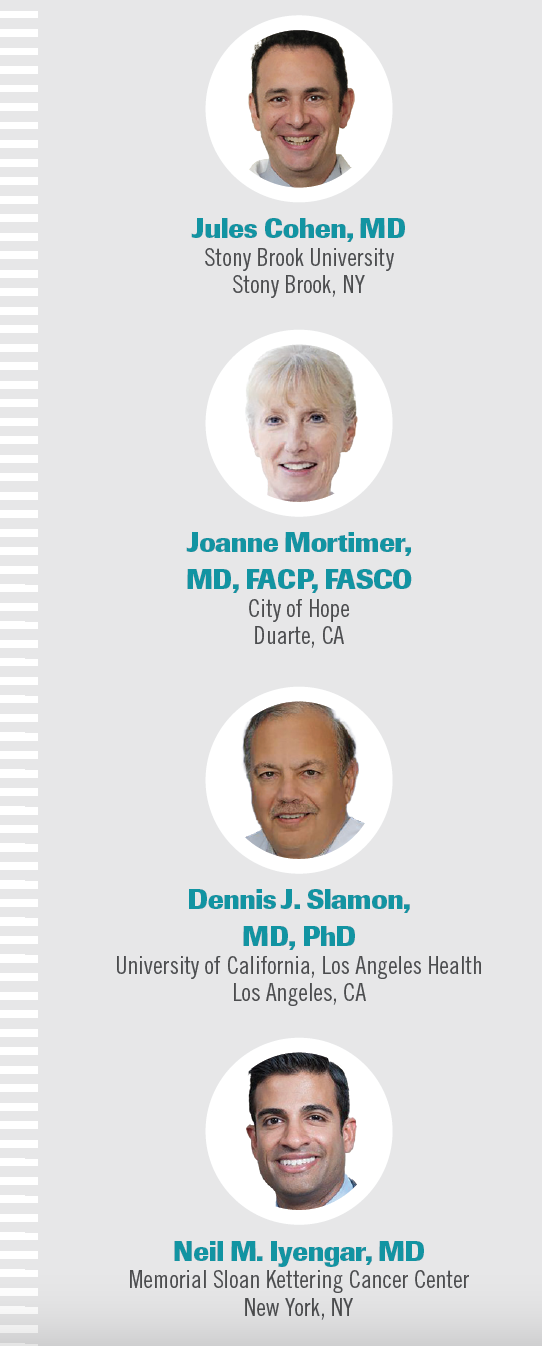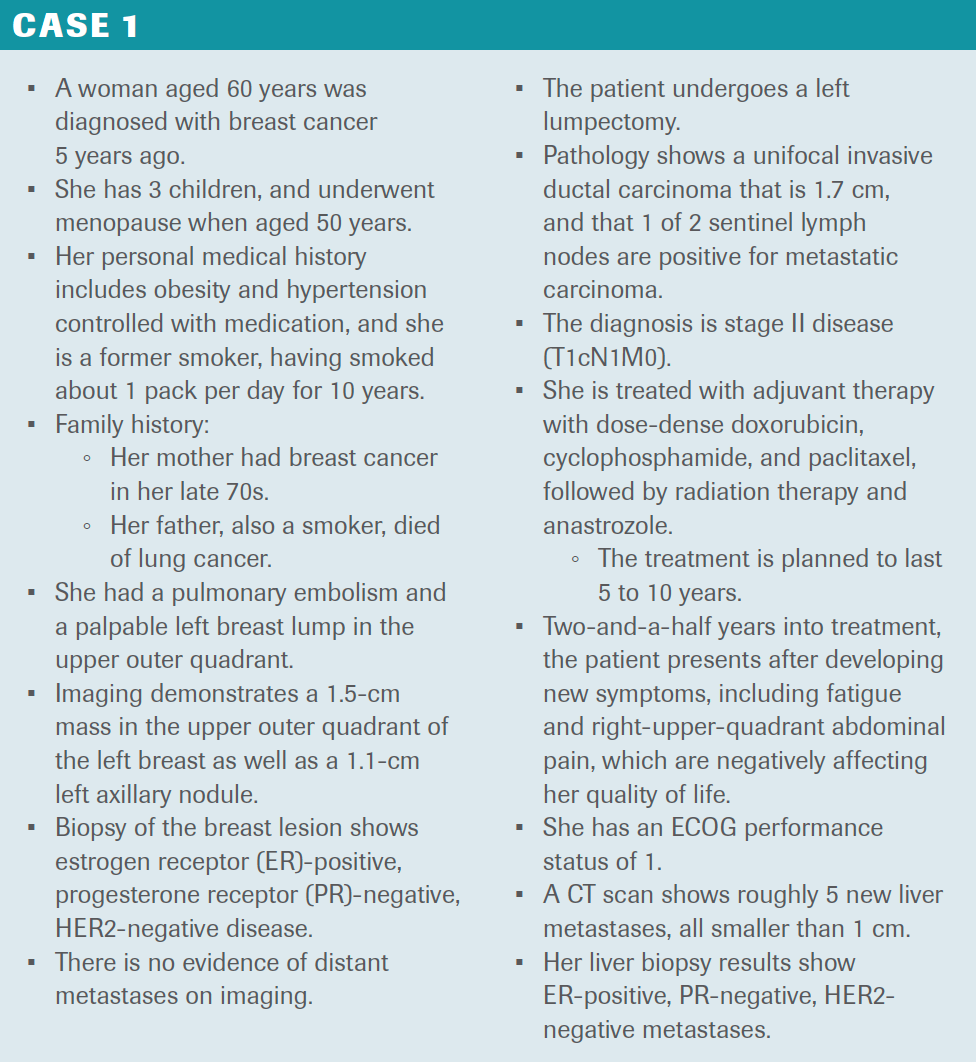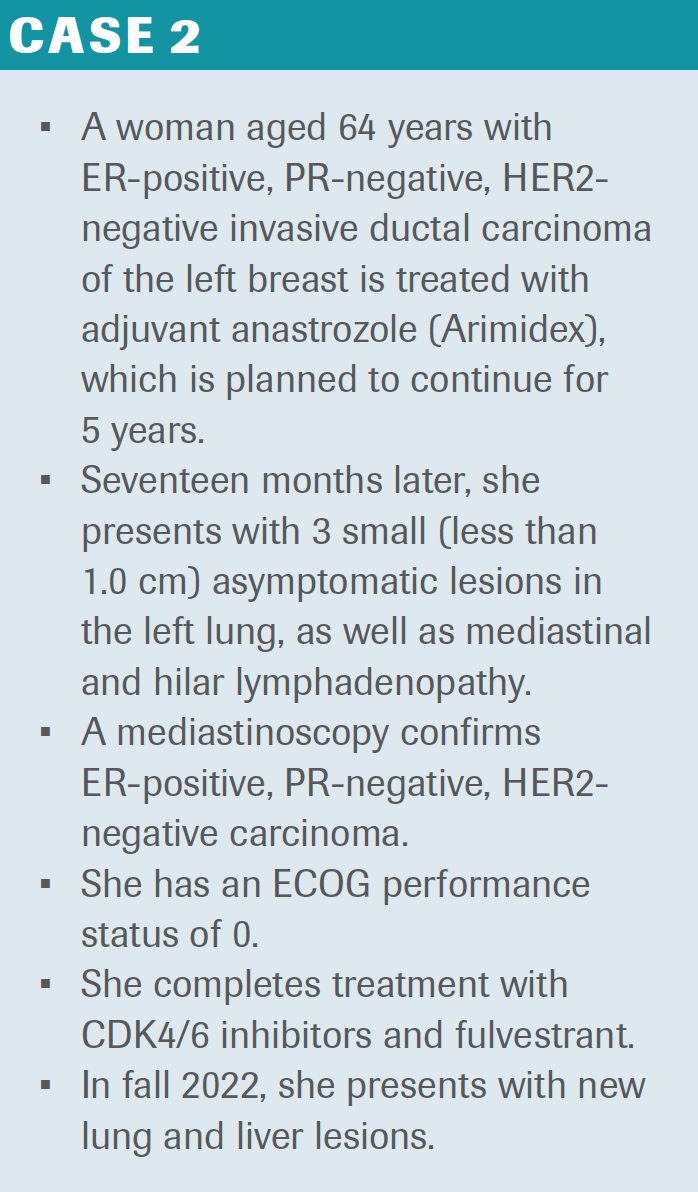Recap: Treatment Paradigms in Metastatic Breast Cancer: Real-world Patient Cases
Experts review the most recent data and discuss current strategies for the management of HR+ metastatic breast cancer.

At an Around the Practice® program hosted by CancerNetwork®, a panel of experts discussed optimal treatment strategies for hormone receptor (HR)-positive, HER2-negative metastatic breast cancer in the wake of recent advancements. The discussion was led by Jules Cohen, MD, clinical assistant professor of medicine at the Renaissance School of Medicine at Stony Brook University in New York.
The panelists were Joanne Mortimer, MD, FACP, FASCO, the Baum Family Professor in Women’s Cancers and vice chair of the Department of Medical Oncology & Therapeutic Research at the City of Hope National Medical Center in Duarte, California; Dennis J. Slamon, MD, PhD, director of clinical/translational research, director of the Revlon/UCLA Women’s Cancer Research Program at Jonsson Comprehensive Cancer Center, and executive vice chair for research of the Department of Medicine at the University of California, Los Angeles; and Neil M. Iyengar, MD, associate attending physician at the Memorial Sloan Kettering Cancer Center and professor of medicine at Weill Cornell Medicine in New York, New York.
Metastatic Breast Cancer Case
Patient Case 1

COHEN: Would you have done anything differently regarding the patient’s initial testing or imaging? (Patient case 1)
MORTIMER: This woman would’ve been a candidate for the phase 3 RxPONDER trial [NCT01272037] and should’ve had her primary tumor submitted for oncotype testing.1 The use of chemotherapy would’ve been based on those results, because if her oncotype [score] was low, we probably wouldn’t [have given] her chemotherapy.
RxPONDER took women with lymph node–positive disease, both pre- and postmenopausal, and examined oncotype score. RxPONDER randomized patients with lower oncotype scores to receive chemotherapy with endocrine therapy. Everyone with oncotype scores of 25 or higher received chemotherapy. The patients [with scores lower than 25] were randomized to receive endocrine therapy with or without chemotherapy.
In the premenopausal group, there appeared to be an improvement in progression-free survival [PFS] for patients who received chemotherapy. For postmenopausal women, there’s no need to give chemotherapy.
If this patient had a lower oncotype score [she therefore] would not have been recommended for chemotherapy. If her oncotype score was higher, she would’ve gotten chemotherapy.
IYENGAR: Updated data from Sparano et al at the 2022 San Antonio Breast Cancer Symposium [SABCS] showed that the premenopausal group [of the phase 3 TAILORx trial; NCT00310180] with [oncotype] scores from 21 to 25 benefited from chemotherapy in the adjuvant setting.2 Premenopausal women with slightly lower scores, starting at 16, also appeared to derive benefit if they were also clinically high risk. In that population, we still use clinical features to help stratify who may or may not benefit from chemotherapy.
COHEN: For postmenopausal women with oncotype scores of 26 and above, would you stratify their chemotherapy based on said score?
IYENGAR: In the postmenopausal population, a benefit to chemotherapy wasn’t observed [in TAILORx] in those with scores lower than 25. Oncotype score has not been validated [as a tool to help] select [among] chemotherapy regimens. I [therefore] wouldn’t use it as a selection tool, but rather as a binary yes or no: Should I be using chemotherapy in this patient or not?
We can look to clinical features [to select among treatments]. We can also perhaps employ [the prognostic tool] RSClin, which incorporates oncotype, to give us more perspective on a particular patient’s risk and whether to use anthracycline-based therapy.
COHEN: How similar is this patient to those you might see in your practice? How would you normally treat patients like her?
MORTIMER: I think RxPONDER has changed how much neoadjuvant therapy we use. This woman did have a palpable node on presentation. Many times, people assume you should give chemotherapy if a patient has a positive node because this is an aggressive disease. However, RxPONDER showed that if you [employ] surgery first for HR-positive breast cancer, complete responses are rare. Downstaging those patients for lumpectomy may be a reasonable expectation of neoadjuvant therapy, but a pathologic complete response is not. RxPONDER has taught us that we should probably take these women to surgery and learn their biology before we decide how to treat them systemically.
COHEN: This patient has received all her treatment, and now she’s receiving her maintenance aromatase inhibitor. How would you monitor her going forward?
IYENGAR: Clinical monitoring is our best tool to watch for recurrence. Certainly, [I would] bring the patient in for regular breast exams; an annual mammography is the predominant way I monitor these patients. I would also add that patients on adjuvant hormone therapy, especially if they’ve received chemotherapy, are at risk for other long-term comorbidities in the survivorship setting, particularly cardiometabolic comorbidities. Ensuring that this patient is following up with her primary care physician, as well as routine health screening and screening for other cancers, is an important part of cancer survivorship.
Frontline Treatment
COHEN: What are the current best practices regarding first-line therapy for metastatic ER-positive disease?
SLAMON: There are sufficient data at this point showing that these patients benefit substantially from a combination of hormonal therapy and CDK4/6 blockade. There are now 3 approved CDK4/6-targeted drugs with similar hazard ratios that benefit PFS. Two of those have now reported overall survival [OS] data, which are very positive. This is currently the right treatment in this setting.
COHEN: Do we have a preference as to which CDK4/6 inhibitor is most effective?
MORTIMER: My preference is for ribociclib [Kisqali] because it seems to have the best survival data. There are issues with administration, and with checking cardiac function. However, given the OS improvement, it’s worthwhile to give those regular electrocardiograms and [check for] corrected QT prolongation every 2 weeks for the first 6 weeks, because survival is the most important end point for these women.
IYENGAR: I agree. Ribociclib is my default choice in the metastatic setting because of the OS data. When thinking about ribociclib or abemaciclib [Verzenio] from a toxicity standpoint, [we should keep in mind that] patients have to deal with diarrhea on abemaciclib, whereas neutropenia is not typically a day-to-day toxicity that impacts the patient experience. [Therefore], even from a toxicity standpoint, I prefer ribociclib.
In certain scenarios I might consider upfront abemaciclib over ribociclib, particularly if I think central nervous system protection might be important for a patient. Ribociclib is now my agent of choice in the first-line setting.
COHEN: Why does palbociclib [Ibrance] still have the lion’s share of the market vs these other 2 drugs?
SLAMON: Being the first out of the gate makes a big difference. Palbociclib [Ibrance] had a head start of at least a year on the observation that this class of drugs makes an impact on PFS.
I agree that our default drug of choice if the patient doesn’t have any cardiac problem is ribociclib. The data are compelling. There’s some controversy around the question of whether these drugs are all the same. They are clearly different. They all have the same target, [but] they each clearly inhibit CDK4/6 a bit differently. Abemaciclib is a much broader inhibitor; in a sense it’s a “dirty” kinase because it hits many other things besides CDK4/6, which may be a benefit or a liability. Time will tell. There’s also the matter of the gastrointestinal toxicity.
COHEN: Should clinicians favor fulvestrant or an aromatase inhibitor in the first line?
IYENGAR: This is a very patient-specific decision. My default is an aromatase inhibitor, [especially when] thinking about subsequent lines of therapy, and what my endocrine therapy partner may be.
However, for an individual who relapsed on adjuvant aromatase inhibition, or someone who has a natural history consistent with ESR1 mutation, or if we identify [a risk of this mutation] using next-generation sequencing in the first-line setting, I might use fulvestrant instead.
Patient Case 2
Patient Case 2

COHEN: What dosing regimen would you consider for this patient?
IYENGAR: This is a patient for whom I’d consider using fulvestrant, particularly given her previous relapse on an aromatase inhibitor. I would also consider clinical trial availability, especially any ongoing trials combining oral selective ER degraders with CDK4/6 inhibition. Otherwise, this is a patient I would treat with fulvestrant plus ribociclib.
COHEN: Let’s say she was 2 years off medication and then relapsed. Would you use a different aromatase inhibitor?
IYENGAR: With a 2-year disease-free interval, I would be comfortable using an aromatase inhibitor plus CDK4/6 inhibition.
COHEN: What would you expect from a routine patient with first-line, metastatic, ER-positive disease receiving fulvestrant and CDK4/6 inhibition? How long would you estimate they could tolerate that medication? What would their progression look like, and what would you think about for second-line therapy?
SLAMON: The second-line therapy might be guided by molecular analyses of the tumor. If the patient had a PI3K pathway mutation, that would [make me consider] something in a salvage regimen that included alpelisib. Everolimus [Afinitor] is another option for a PI3K-driven tumor. It’s challenging to give, at least in my experience. There are a lot of adverse effects [AEs] to manage with everolimus, but it’s workable.
Both of those are options for patients who progress, but the appropriate first-line treatment was given to the patient you described. Those are the options afterward.
PI3K Pathway Mutations
COHEN: When should clinicians test for a mutation in the PI3K pathway?
MORTIMER: I tend to check at relapse, and often after the disease progresses a second time. One of the questions is: Do you check on the tumor? [And further], do you perform a liquid tumor biopsy? There’s a lot of heterogeneity, and [a patient] can have different mutations in the tumor or in the metastasis.
I tend to do serum testing rather than biopsies for PI3K. I do it again at relapse and at subsequent progression. If you find out the patient has ESR1 mutations, you may not [want to] use an aromatase inhibitor, so you’ll want some guidance as to what will work and what might not work.
COHEN: Do you use prophylaxis with any medications when you administer alpelisib, or do you wait to see if they develop AEs?
MORTIMER: Giving alpelisib can be challenging. Our order set for alpelisib [includes] an immediate consultation with endocrinology. In the first 6 months of using alpelisib, we had several patients who came in [with] diabetic ketoacidosis at day 7, even though maximum glucose elevation is around day 15. We routinely begin diabetic education the minute we start patients on alpelisib, [led by] diabetes educators. These patients don’t need a physician intervention; they see a diabetes educator when starting alpelisib. We haven’t had anyone admitted for glucose problems since we initiated that program. We also have more people using alpelisib.
It’s a scary drug if you haven’t had experience with it because medical oncologists are not [typically] good endocrinologists outside the context of breast cancer endocrine suppression. We aren’t trained to manage patients’ diabetes. [Our approach] has turned out to be an effective strategy.
COHEN: Are the other PI3K-specific inhibitors in development, targeting the H1047X mutation and other common mutations, likely to be successful vs alpelisib?
IYENGAR: Time will tell. The allele-specific PI3K inhibitors in testing right now [are designed to help patients avoid developing] hyperinsulinemia and hyperglycemia, and [to achieve] more targeted inhibition of PI3K. I’m eager to see the efficacy data from that class.
This is partly why I advocate for early tumor sequencing. We presented data at the 2022 American Society of Clinical Oncology Annual Meeting identifying body mass index and other metabolic parameters as predictors of worse hyperinsulinemia and hyperglycemia during alpelisib treatment.3 If you can identify your patient as a candidate for alpelisib earlier, it provides an opportunity to institute lifestyle modifications, some nutritional counseling, and potentially even weight loss to reduce the metabolic risk.
COHEN: This is not the FDA-approved indication, but I prophylax with both metformin and loratadine because the incidence of ratio hyperglycemia is so high, and metformin is generally well tolerated.
IYENGAR: That’s a fair strategy. Data from the phase 2 METALLICA trial [NCT04300790] supported the use of metformin for managing the hyperglycemia associated with alpelisib.4 However, there are data suggesting that alpelisib eliminates the mechanism of action through which metformin is supposed to help [minimize] hyperglycemia. Other ongoing trials in Europe and the United States are testing other diabetes medications, such as SGLT2 inhibitors, as well as dietary approaches, [including] ketogenic and low-carbohydrate diets.
Endocrine Therapy and Antibody-Drug Conjugates
COHEN: What are some mechanisms to overcome resistance to endocrine therapy?
SLAMON: One of the clear mechanisms has been the activation of the PI3K pathway. The upregulation of a nonmutated variant can also participate in the resistance phenomenon.
There have been strategies using triplet therapy, in which you add the PI3K inhibitor upfront with CDK4/6 and endocrine blockade. Sadly, those [regimens] have been very poorly tolerated by patients, and the trials using the current suite have been stopped. We’ll see if that changes with newer suites.
[Depending on] ESR1 mutation status, hormonal blockade with aromatase inhibitors is another mechanism. There are also data [supporting] CDK4/6 [blockade], although there’s no clear biologic reason why that [strategy] should [work]. It would be good to see that [possibility] explored more.
Some of the proteolysis-targeting chimera molecules are even better degraders of the ER and might be more effective in this pathway.
COHEN: Why are some of these treatments biomarker dependent? We need to see a PIK3CA mutation to use alpelisib, but why don’t we need something similar to use an AKT or mTOR inhibitor?
SLAMON: We’re learning that [for some] targets, it’s necessary to identify that it’s playing a role in the pathogenesis of the tumor. For other targets, it’s irrelevant.
For some of the surface membrane proteins targeted with antibody-drug conjugates, it doesn’t matter whether they play a role in the pathogenesis. If the antibody attaches and the complex is internalized and released inside [the cell], you’ve achieved activity.
[However], there won’t be a one-size-fits-all approach. Some targets will require a biomarker. It’ll be on a case-by-case basis.
Final Thoughts
COHEN: Is there anything else to note about this disease space?
MORTIMER: An ongoing ECOG-ACRIN phase 2 trial [NCT02398773] recently completed accrual and will assess if F-18 16 α-fluoroestradiol–PET imaging predicts for responsiveness to endocrine therapy with CDK4/6 inhibitors. Importantly, this trial will help reveal which patients do not respond to endocrine therapy, which may be more important [than who does respond] because you wouldn’t need to waste time using endocrine therapy for these patients. [You could] skip right to nonendocrine interventions.
IYENGAR: We’re pushing the needle in terms of time to chemotherapy. This is particularly important for younger patients with metastatic disease. The field is moving toward sparing folks from chemotherapy, at least in earlier lines of treatment. The number of lines before we have to resort to chemotherapy are continually increasing. This is very encouraging.
SLAMON: Coming out of the 2022 SABCS, the spectrum of [emerging] therapeutic options is exciting. [These new therapies] are effective in a clinically meaningful way. You don’t need to be sitting in the first row to see the difference in the Kaplan-Meier survival curves. The differences are getting to be rather impressive when we know which therapeutics to administer to which subpopulation.
COHEN: For many of our patients [with metastatic disease], particularly those with ER-positive, HER2-negative disease, and particularly if they have bone-only disease or better prognostic features, this has become more of a chronic disease than a lethal or terminal one. We can share that with our patients to give them hope while moving through treatment, even for years at a time.
References
- Kalinsky K, Barlow WE, Gralow JR, et al. 21-gene assay to inform chemotherapy benefit in node-positive breast cancer. N Engl J Med. 2021;385(25):2336-2347. doi:10.1056/NEJMoa2108873
- Sparano J, Gray RJ, Makower D, et al. Trial assigning individualized options for treatment (TAILORx): an update including 12-year event rates. Presented at: 2022 San Antonio Breast Cancer Symposium; December 6-10, 2022; San Antonio, TX. Abstract GS1-05.
- Shen S, Chen Y, Carpio A, Chang C, Iyengar NM. Characterization of alpelisib-associated hyperglycemia in metastatic breast cancer. J Clin Oncol. 2022;40(suppl 16):abstr 1016. doi:10.1200/JCO.2022.40.16_suppl.1016
- Ruiz Borrego M, Tolosa P, Blanch S, et al. Metformin (MET) for the prevention of alpelisib (ALP)-related hyperglycemia (HG) in PIK3CA-mutated, hormone receptor-positive (HR[+]) HER2-negative (HER2[–]) advanced breast cancer (ABC): the METALLICA study. Presented at: 2022 San Antonio Breast Cancer Symposium; December 6-10, 2022; San Antonio, TX. Abstract PD8-02.

Newsletter
Stay up to date on recent advances in the multidisciplinary approach to cancer.